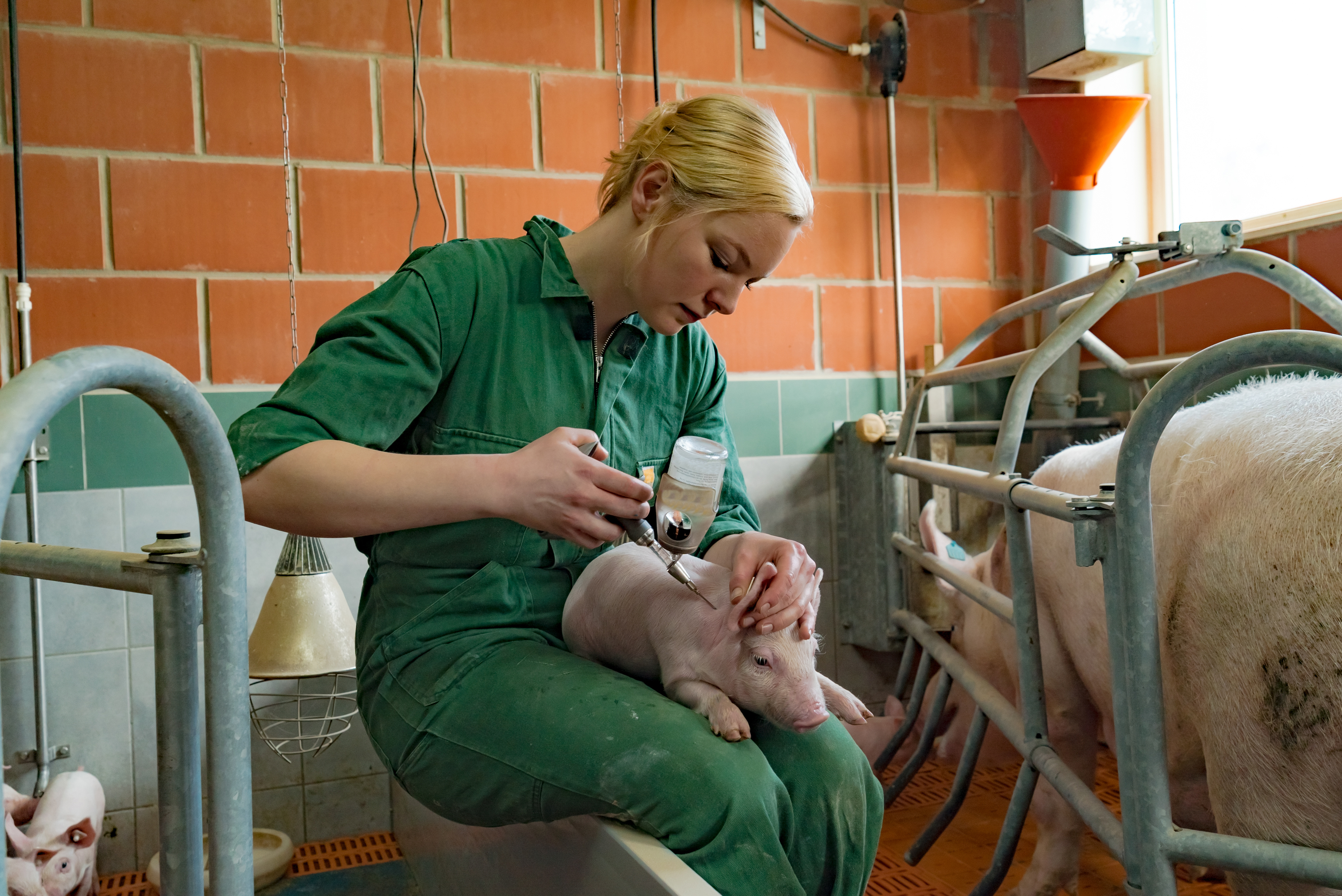



Could pain management be the missing piece for pig productivity?
How can pain be identified; how can it be treated; and how will pain relief feature in the future of pig production?
In the United States alone, over 34 million male piglets were castrated without pain management in 2018 (USDA, 2018). Pain experienced by pigs as a result of production procedures such as a castration and tail docking has become a controversial area of debate among consumers, legislatures, and producers. Identifying, assessing and managing pain in a timely manner to prevent extensive animal pain and suffering is an ethical obligation for all that work in the swine industry. This article will define pain, how we identify and manage it, and will address what are the future implications for pain management for commercial swine industries.
What is pain?
Pain in animals has been defined as an aversive sensory experience that changes the animal's physiology and behaviour (Molony & Kent, 1997). Pain is an important condition that adversely affects an animal’s quality of life and when left unmitigated, can result in distress and detrimental effects to the animal’s physical health (Hellebrekers, 2000).
Identifying and diagnosing pain
The goal of any producer is to accurately and effectively identify pain in pigs, diagnose what is causing the pain, and ultimately control pain. Pain diagnosis is a difficult process due to unique individual pain experiences (Gaynor & Muir, 2009). However, assessing the presence and experience of pain in animals is paramount in reaching solutions to mitigate or eliminate pain altogether (Rutherford, 2002).
Research to date has employed three approaches for assessing pain on farm:
1. general body function and maintenance (i.e. food or water intake, growth, and production).
2. Physiological indicators of pain (i.e. cortisol, heart rate, or blood pressure).
3. Behavioural changes at the pig level. Behaviours to evaluate pain sensitivity can be categorised as either pain specific behaviours (i.e. tail wagging, prostrating, rump scratching) or deviations in normal behaviour (i.e. increased nursing, inactivity and aggression amongst littermates). Piglets undergoing castration demonstrate increased pain specific behaviours and alter normal maintenance behaviours up to 5-7 days post-procedure.
Castration
Surgical castration is a routine procedure practiced around the globe that involves physically removing the testicles from male piglets. This procedure is primarily conducted on commercial swine facilities as a means to eliminate unwanted breeding, decrease aggressive behaviour (Bjorklund & Boyle, 2006) and improve meat quality by eliminating boar taint (Griffiths & Patterson, 1970). Literature dating back to the early 1990’s has consistently demonstrated that surgical castration is painful based on observed physiological and behavioural deviations of the piglet (White et al., 1995).
In an attempt to eliminate this pain, alternative methods to castration have been evaluated. This includes raising intact boars, immunocastration, sexed semen, and genetic modifications (AVMA, 2013). Australia currently utilises immunocastration, a vaccine that chemically castrates the male pig, while many countries in Europe raise intact boars, eliminating the need for castration altogether. However, many countries including the United States, China, Denmark, Mexico and Brazil still primarily castrate piglets without the use of pain management. Given the known welfare implications associated with castration, identifying techniques to mitigate pain associated with this procedure in today’s industry is critical.
Options for pain management
Pain can be managed on farm through the use of pharmacological interventions which involve administration of drugs to mitigate or alleviate the pain response. For a drug to be utilised in a commercial setting, it must be readily and safely accessible to producers, and both efficient in terms of labour and cost. The two most promising options for on-farm pain management include |local anaesthetics and analgesics.
Local anaesthetics work by blocking any painful sensation in the affected area from reaching the brain (Mao & Chen, 2000). A common local anaesthetic currently implemented in livestock systems is lidocaine. In pigs, lidocaine can be injected or applied topically to an area and begin functioning within 10 minutes of application (Haga & Ranheim, 2005).
Analgesics are drugs specifically used to alleviate pain. An example of these are non-steroidal anti-inflammatory drugs (NSAIDs) which include meloxicam, flunixin meglumine and ketoprofen. These drugs do not block sensation, but rather alleviate pain by reducing inflammation of injured tissue.
Implementing administration of either local anaesthetics or analgesics in a pre-emptive manner can provide pain relief at the time of and several hours following castration. Implementing this pharmaceutical approach can minimise pain sensitivity although pain experienced by the pig cannot be eliminated.
The future of pain management in livestock
In 2010, the European Commission set the goal to phase out surgical castration in all countries in the European Union by 2018. In the Unites States in 2014, Tyson® Foods, the third largest US pork packer (National Pork Board, 2018), released a statement to its pork producers identifying “supporting the use of pain mitigation (such as anaesthetics or analgesic) for tail docking and castration of piglets” as one of its goals. According to Canadian Codes of Practice, as of 2016, any piglet castrated must be administered analgesics to control post-procedural pain. These events highlight a change in the livestock industry. As consumers around the world become increasingly concerned with animal welfare, pressure is placed on producers to manage pain. It is critical that people involved in livestock production understand the challenges faced in identifying and alleviating pain in animals and implement solutions that can realistically and effectively manage pain on farm.
| References | ||||
|---|---|---|---|---|
| AVMA | ||||
| (2013) | Literature review on the welfare implications of swine castration. | |||
| Bjorklund L & Boyle L | ||||
| (2006) | Effects of finishing boars in mixed and single sex groups and split marketing on pig welfare. Acta Veterinaria Scandinavica 48, 2006. | |||
| Gaynor J & Muir W | ||||
| (2009) | Handbook of veterinary pain management. | |||
| Griffiths N & Patterson R | ||||
| (1970) | Human olfactory response to 5a-androst-16-en-3-one; principal component of boar taint. J Sci Food and Agriculture 21, 1970. | |||
| Haga H & Ranheim B | ||||
| (2005) | Castration of piglets: the analgesic effects of intratesticular and intrafunicular lidocaine injection. Veterinary Anesthesia and Analgesia, 32:1-9, 2005. | |||
| Hellebrekers L | ||||
| (2000) | Animal pain: a practice-oriented approach to an effective pain control in animals. | |||
| Mao J & Chen L | ||||
| (2000) | Systemic lidocaine for neuropathic pain relief. Pain 87:7-17, 2000. | |||
| Molony V & Kent J | ||||
| (1997) | Assesment of acute pain in farm animals using behavioural and physiological measurements. J Anim Sci 75:266-272, 1997. | |||
| National Pork Board | ||||
| (2018) | U.S. Packing Sector. Accessed November 13, 2018. | |||
| Rutherford K | ||||
| (2002) | Assessing pain in animals. Animal Welfare 11:31-53, 2002. | |||
| USDA | ||||
| (2018) | Quarterly Hogs and Pigs. National Agricultural Statistics Service, 2018. Accessed November 13, 2018. | |||
| White R, DeShazer J, Tressler C, Borcher G, Davey S, Waninge A, Parkhurst A, Milanuk M, Clemens E | ||||
| (1995) | Vocalization and physiological response of pigs during castration with or without a local anaesthetic. J Anim Sci 73:381-386, 1995. |










